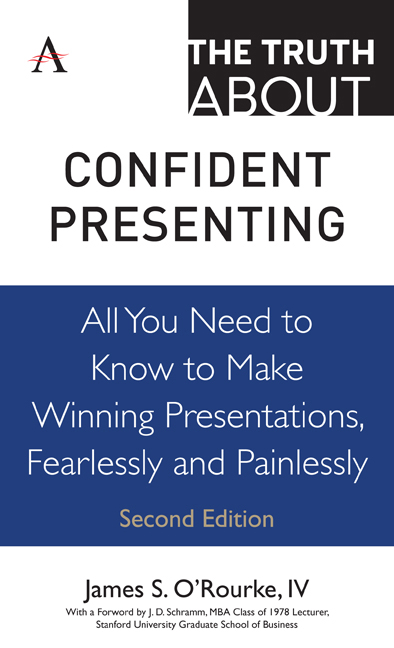 The Truth about Confident Presenting
The Truth about Confident Presenting Book contents
- Frontmatter
- Contents
- Foreword
- Introduction
- Part I Some Initial Truths
- Part II The Truth About Getting Ready to Speak
- Part III The Truth About What Makes People Listen
- Part IV The Truth About Developing Support for Your Presentation
- Truth 19 Develop support for your presentation
- Truth 20 Understand the power of your content
- Truth 21 The kinds and quality of evidence matter to your audience
- Truth 22 Structure can help carry an inexperienced speaker
- Truth 23 Find support for your presentation
- Truth 24 Use the Internet to support your presentation
- Part V The Truth About Getting Up to Speak
- Part VI The Truth About Managing Anxiety
- Part VII The Truth About Nonverbal Communication
- Part VIII The Truth About Visual Aids
- Part IX The Truth About Handling an Audience
- Part X The Truth About What Makes a Presentation Work
- References
- Acknowledgments
- About the Author
Truth 20 - Understand the power of your content
from Part IV - The Truth About Developing Support for Your Presentation
- Frontmatter
- Contents
- Foreword
- Introduction
- Part I Some Initial Truths
- Part II The Truth About Getting Ready to Speak
- Part III The Truth About What Makes People Listen
- Part IV The Truth About Developing Support for Your Presentation
- Truth 19 Develop support for your presentation
- Truth 20 Understand the power of your content
- Truth 21 The kinds and quality of evidence matter to your audience
- Truth 22 Structure can help carry an inexperienced speaker
- Truth 23 Find support for your presentation
- Truth 24 Use the Internet to support your presentation
- Part V The Truth About Getting Up to Speak
- Part VI The Truth About Managing Anxiety
- Part VII The Truth About Nonverbal Communication
- Part VIII The Truth About Visual Aids
- Part IX The Truth About Handling an Audience
- Part X The Truth About What Makes a Presentation Work
- References
- Acknowledgments
- About the Author
Summary
After making some judgments about the occasion, the topic on which you're speaking, and you as a speaker, your audience will turn their attention to actual content of your speech. That content will be heavily influenced by its purpose. As you've seen, different audience members react in varying ways to different kinds of evidence, so the material you select should not only reflect your purpose and the psychological needs of the audience, but it should also accurately and honestly reflect the subject itself. Your content will generally fall into several of these categories:
Descriptions and explanations. Objects are customarily described, while processes and ideas are explained. If you were to give a talk, for example, on the operation of a digital music player (such as an iPod or an iPhone), you may first have to describe what a digital music player is and how it works, followed by an explanation of the processes involved in purchasing and downloading music selections from an Internet source and storing them on your hard drive or mobile device. Providing visual reinforcement is always helpful as you describe and explain your topic, but your most powerful ally in reaching the audience will be clear and accurate language.
Comparison and contrast. Comparison is used to show similarities between something known to the audience and something new that is introduced to them. Contrast, on the other hand, is an attempt to make a topic or point clear by showing how it differs from some other concept that is familiar to the audience.
Examples, illustrations and anecdotes. These are common forms of amplification that are only slightly different from one another. In a recent commencement address, Xerox Corporation Chairman and CEO, Anne Mulcahy, cited examples of ethical failures among business leaders in support of her contention that executives should be more focused on servant leadership than personal achievement. In one anecdote about her promotion to the top job at Xerox, Ms. Mulcahy told the story of her decision to refund money taken by a predecessor 20 from the employee retirement fund. That decision won her numerous fans among Xerox employees and retirees but very few friends on Wall Street, as it involved a significant charge against earnings. She did it because she honestly believed it was the right thing to do.
- Type
- Chapter
- Information
- The Truth about Confident PresentingAll You Need To Know To Make Winning Presentations, Fearlessly And Painlessly, pp. 77 - 80Publisher: Anthem PressPrint publication year: 2019


